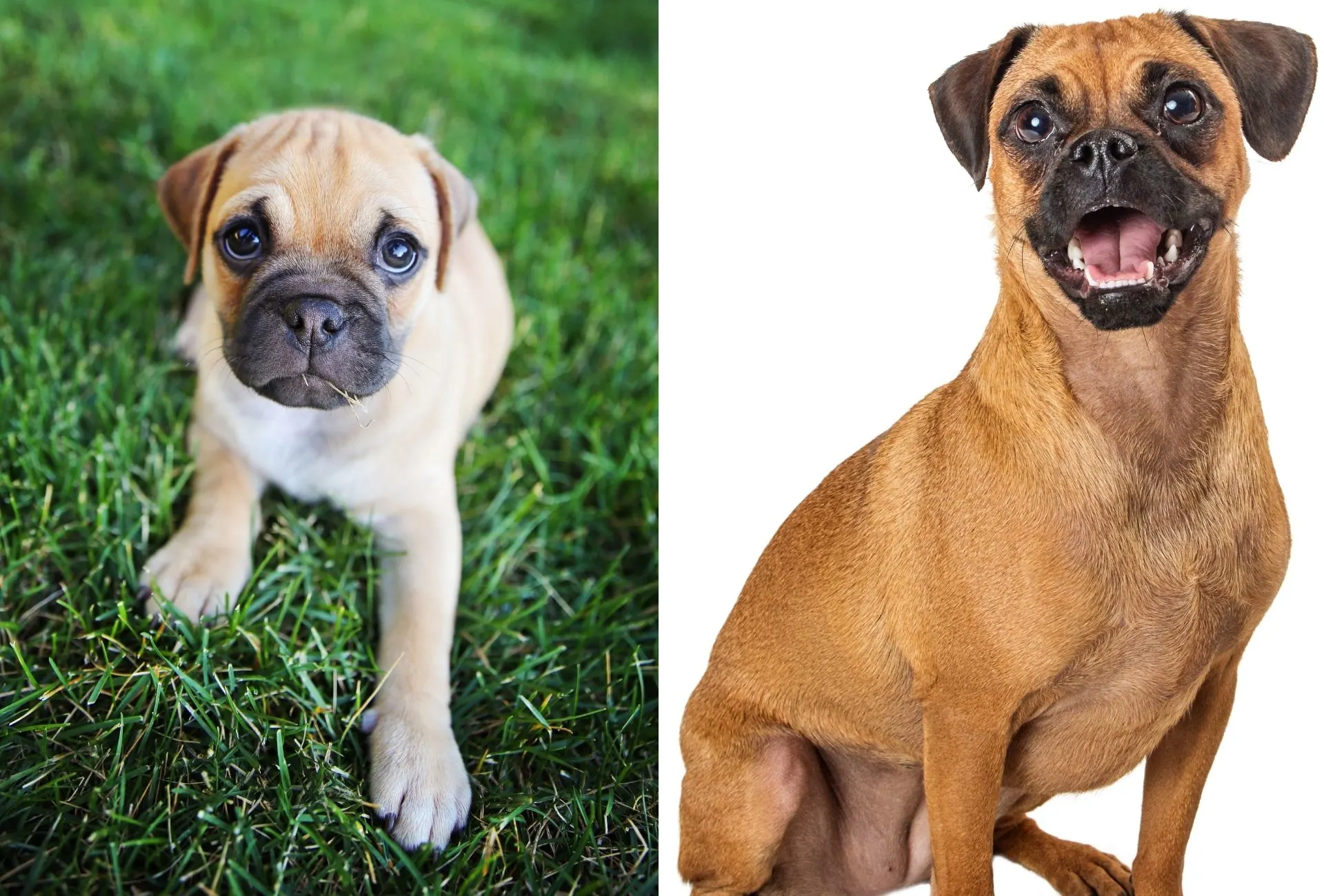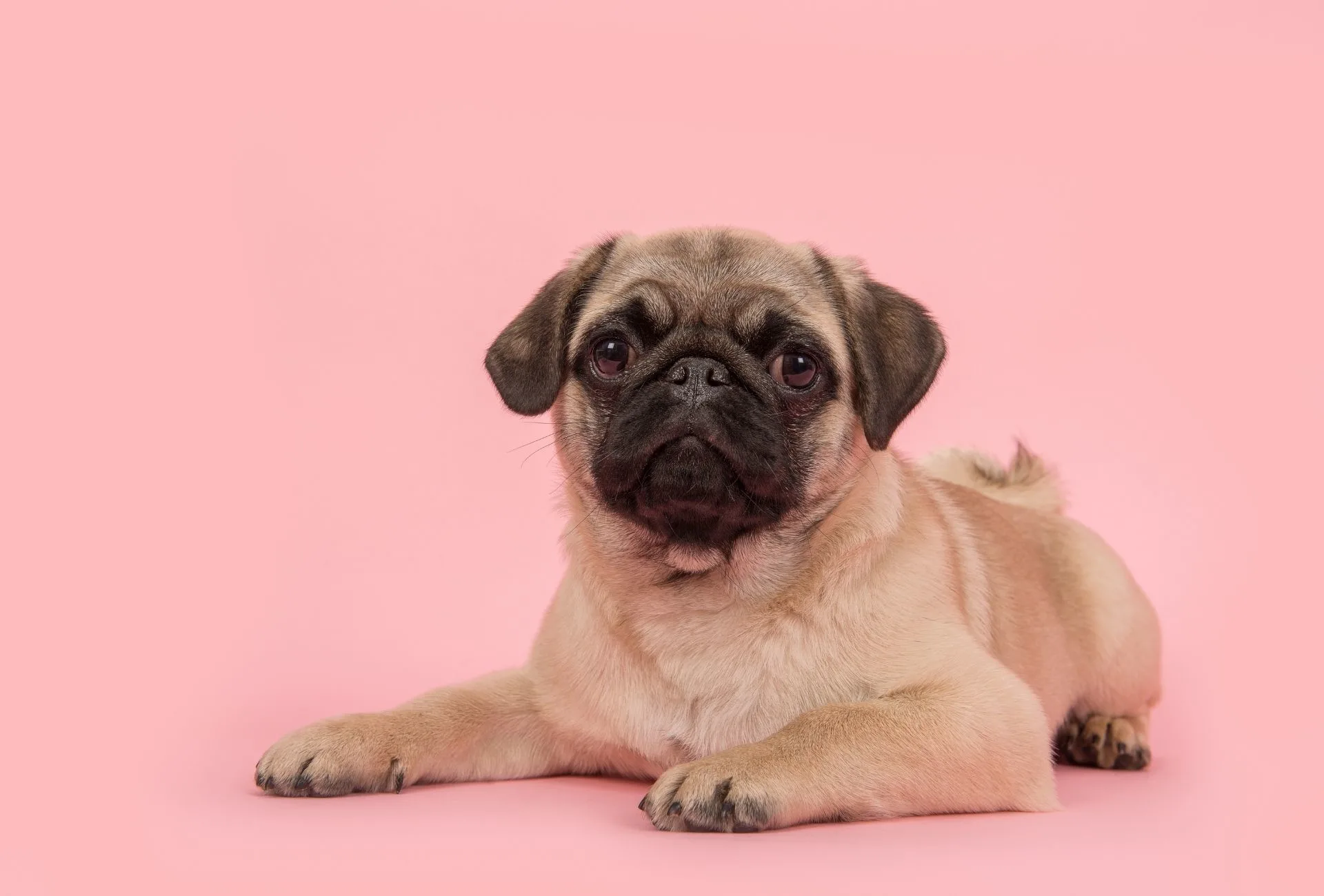Pugs and all their features are a sight to behold.
At least that’s what breed enthusiasts would tell you.
Where Pug lovers see a cute snout, researchers, medical staff, and concerned dog owners see a respiratory issue waiting to happen.
Where Pug lovers see a cute skull, others wince at the thought of that skull having to accommodate a full-sized brain.
Where Pug lovers listen to that sweet little snort, others are concerned the dog might collapse any minute.
The thing is, many people don’t know that we created the Pug that way and we could just as easily end it.
And yet, we decide to keep breeding these adorable lovebugs because… well just because we can.
Despite the obvious health issues, self-appointed Pug advocates love the look and will defend their beloved breed standards at all costs.
Yes, that’s right the breed standards don’t even advocate stopping these cruel breeding practices.
Pugs Before and After Breeding
Before selective breeding, Pugs had longer snouts, regular-shaped faces, fewer wrinkles, no bulging eyes, and even a different gait and sometimes a straight tail.

This difference between the Pug before and after selective breeding is directly correlated to a variety of health issues.
Among these are:
- Respiratory issues
- Sleep apnea
- Encephalopathy (skull too small for brain)
- Skin issues
- Eye issues (most ofen bad eyesight up to blindness)
- Hip dysplasia
The respiratory issues alone are responsible for a host of medical grievances Pugs have to deal with.
Unable to cool down effectively, not getting the appropriate oxygen supply, or dying in their sleep due to breathing issues are all possible issues Pugs face.
Possible telltale signs (apart from the appearance) of struggling Pugs are plentiful.
Have you ever seen a Pug walking with his mouth open all the time despite not being heavily exercised or outside on a hot day?
Have you ever seen a Pug snort extremely loud for seemingly no reason?
Have you ever seen a Pug lie down in the shade with all four legs splayed to the sides?
These are all results from the so-called selective breeding that created the modern Pug.
All this just to create this super tiny snout.
To many, these looks aren’t even cute anymore and just appalling instead. Bulging eyes, wrinkles all over the body and, more often than not, overweight.
Really, how can a snout that’s nearly pressed inwards look cute to some?
It’s a facial feature that also impacts the skull shape when compared to ancient paintings of Pugs.
All these issues contribute to a decreased lifespan for Pugs.
Are Pugs Selectively Bred?
Yes, pugs are selectively bred so are technically all modern purebred dogs. However, the Pug was bred for specific, unhealthy facial traits.
The selective breeding happened partly by pushing the upper jaw backward which caused the nasal passage compression, wrinkles on the head, and deformed eyes.

Not only was the Pug selectively bred, but people are also not providing the appropriate level of care.
Despite their potential pet being plagued by health issues, people will straight away ignore these to get the Pug just like they want him to be.
Since the plethora of health issues can’t be denied, they’ll rationalize it.
You’ll often hear Pug owners state that Pugs are prone to sinus infections due to their short snout like that’s all there is to it.
These statements do two things: Diminish the threat these health issues pose and avoid the real issue.
As if breeding Pugs this unhealthy way with respiratory issues is the only possible way to call one of them your own.
Also, every other Pug I see – no matter if it’s out and about or on Social Media – is overweight.
Obesity is a serious issue and no, Pugs are not overweight by default because they love food.
The majority of dogs would tick that box when asked whether or not they’re food-driven.
That doesn’t mean you have to give in to it but Pug owners seem to do it more often than others.
Possibly because dog owners like the look of a chunky Pug. It’s a fat and unhealthy dog, nothing cute about it.
Obesity was also the leading medical condition in this study among over 1000 Pugs, concluding that nearly 70% of them had a health issue.
Surprisingly, this Swedish study found no link between the Pug’s gait and their weight.
However, the study did find out that 1/3 of over 500 Pugs aged 1, 5, and 8 years have trouble walking properly, often related to neurological issues.
How Were Pugs Originally Bred?
Originally, Pugs were bred to healthy, small to medium-sized companions and at that time, the modern Pug’s facial features were not desired at all.
The fact that Pugs look the way they do nowadays is due to pet owners‘ desire to own these creatures and make them look as adorable as possible.
Beauty standards are always subject to change and have been since humanity began so it’s no wonder that this ideal picture of the Pug emerged just recently.
However, while the Pug was resembling today’s Pug since the 20th century, it’s safe to say this has only become a dramatic issue in the past decades.
Many people don’t even know that the Pug is a truly ancient breed.
The Chinese have kept these dogs, as did British royalty and they have found their way into homes all around the world.
Their increase in popularity stems partly from all the hype they gather on social media.
True, their facial features do attract views but what if that comes at the cost of a majority of these dogs?
Pug Breeding Cruelty
Breeding Pugs with extremely short snouts, small and round skulls, and encouraging the image of bulging eyes, skin-irritating wrinkles, and too much weight as puppy-like features can be considered cruelty.
As outlined above, all these issues contribute to serious health issues.
People interested in the Pug and their unhealthy appearance also rarely think about the vet costs associated with this.
Not only will your pet suffer, but your chances of leaving $1,000-$2,500 on the vet’s table for an operation related to their respiratory issues are also high.
Why buy a puppy in need of fixing?
You might ask yourself what can be done about the cruelty of breeding Pugs and there are a few ways:
- Buy a Pug with a longer snout, less wrinkles, healthy eyes and so on from breeders that perform extensive health testing
- Rescue a Pug (beware of the cost and consider health insurance)
- Look for a similar breed
- Investiage the possibility of a Retro Pug
Regarding the last point for Retro Pugs – many breeders have started crossbreeding while keeping the Pug’s features, just in a less exaggerated way.
A favorite for this is the Beagle as their neutral looks and generally good health status alongside their similar size makes them an ideal candidate.
That being said, improving a breed takes multiple generations and decades of work.
If you have found a dog that fits the bill, feel free to go for it but make sure to demand all health testing.
Hip and elbow x-rays, healthy weights of the parents, no eye issues, not too many skin folds, properly-shaped skull – all these issues should help with avoiding irresponsible breeders.
Disclaimer: This blog post does not substitute veterinary attention and does not intend to do so. I am not a veterinarian or pet nutritionist. If your dog shows any sign of illness, call your vet.
Katie
Saturday 21st of May 2022
Good Afternoon,
I have just started researching and looking into a way to become involved in bettering the pug breed. When I was a child my step grandma bred pugs and bulldogs. She unfortunately became greedy and got into many breeds and it was all about the money. Although she was legal and had acceptable clean quarters my parents eventually got her to stop. My aunt kept breeding pugs for awhile but they didn't do it for long. Along the way we had a couple pugs as pets. All of that to say I love this breed and I want to advocate for bringing the healthier version to life. I was hoping you may be able to guide me to researching this and how to proceed in studying genetics and everything I need to know in choosing the right dogs. Now this will not happen for a few years my son will graduate from Highschool next year and our current dogs (all just pets, Chug, Mini Schnauzer, English Mastiff) are up there in age but I want to start studying now. I also want to know how to become part of a wider net of breeders looking to bring back healthy pugs. If you do not know any of these things can you point me in the right direction?
Thanks,